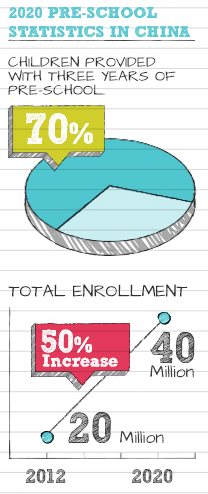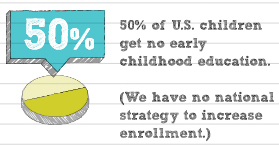China Aiming for the Gold in Starting Kids Early, U.S. is Late to the Game
Cross posted with author permission from the Huffington Post »
In 2010, China and the United States each conducted a national census. China found that 76.0 million of its citizens were children under the age of 5, about four times the number the United States has, 20.2 million. No real surprise there: China’s overall population of 1.34 billion, the most of any country, is four times that of the United States, at 309 million.
What is a surprise – and may well be a major cause for alarm, from an American perspective -- is how many of those Chinese kids are getting a jump start in life through enrollment in early education programs, which researchers say helps build the cognitive, social and emotional skills that give them a greater chance for successful lives.
A new report from the Center for the Next Generation and The Center for American Progress, “The Competition that Really Matters: Comparing U.S., Chinese, and Indian Investments in the Next Generation Workforce” shines a light on the very different – and very aggressive – approaches China and other countries are taking to prepare their young people for the challenges of an increasingly competitive global marketplace. For China, providing early education has become a national priority while in the United States, not so much.
The report serves not only as a wake-up call for American policymakers to take notice of strategies underway elsewhere but also as a reminder that the key jobs of the future – the engines of national economies – will go to the best, brightest and most qualified applicants, no matter what country they come from.
By virtue of its size and population, China stands as the supreme challenger to the United States in global economic leadership. Recognizing the need to take greater advantage of its people as a national asset, China is now making it possible for much larger numbers of youngsters to start their education early as preparation for the in-demand job opportunities of the years ahead.
As our report shows, 51 percent of China’s kids age 3 and 4 in 2009 had at least a year of publicly-supported and subsidized pre-primary schooling, compared with 50 percent of children in the United States who have access to pre-school through both public and private funding. True, the percentages are not so different, but the numbers they represent are staggering: nearly 30 million in China versus 3.5 million in the United States.
If the implications of that disparity aren’t enough, consider this from the report:
“Total state funding for pre-K programs (in the U.S.) decreased by $60 million in 2011, after decreasing by $30 million the previous year. So just as China is ramping up its investments in early childhood education, aiming to serve 80 percent of all 3 and 4 year olds by 2020, the United States is reducing investment in preschool learning and has set no clear national goals to counter China with a bold plan to increase access and improve quality of early learning in our country.”
The specter of those projections – 80 percent of all 3 and 4 year olds by 2020 -- is ominous for the United States, especially if Americans do not change their thinking about the critical value and importance of early education.
For now, in these crazy days of a Presidential election campaign and arguments over budget cuts and tax policy, it seems unlikely that anything is going to change any time soon. Sadly, neither candidate is talking much – if at all – about long-term policies to strengthen the future of the country by expanding educational opportunities for the youngest of Americans – our future leaders.
“The Competition that Really Matters” cited a U.S. Department of Commerce report issued earlier this year that listed three critical needs for fueling global competitiveness that thrives on innovation: research, infrastructure and education, all of which need of a new infusion of investment.
Why?
The World Bank ranks the United States eighth in research and development spending as a percentage of gross domestic product; the World Economic Forum’s Global Competitiveness report ranks the overall condition of U.S. infrastructure 24th in the world, down from 8th place in 2005.
As for education, which the commerce department called “the single critical focal point for U.S. policymakers’ attention, without question,” the United States is anything but a leader. In the last Programme for International Student Assessment (PISA), the most respected measure of country by country performance for children aged 15 and 16, the United States ranked 14th in reading and 25th in math.
For China, only kids in Shanghai and Hong Kong were assessed, but here’s how they fared:
Shanghai: 1 in reading, 1 in science, 1 in math.
Hong Kong: 4 in reading, 3 in science, 3 in math.
In a recent speech at a Children’s Defense Fund conference, Federal Reserve chairman Ben Bernanke framed early education as an economic issue for the United States. Here’s what he said:
“Early childhood programs are a good investment with inflation-adjusted annual rates of return on the funds dedicated to these programs, estimated to reach 10 percent or higher. Very few alternative investments can promise that kind of return. Notably, a portion of these economic returns accrues to the children themselves and their families, but studies show that the rest of society enjoys the majority of the benefits, reflecting the many contributions that skills and productive workers make to the economy."
We have reached a point in the United States where short-term, band-aid approaches to preparing our kids properly for the years ahead aren’t enough. They’re like putting sand in potholes. We need bold, aggressive, long-term, sustainable solutions that contemplate U.S. leadership for years to come. It all starts with early education.
Just ask China.


The views and opinions expressed in this post are those of the author(s) and do not necessarily reflect those of MomsRising.org.
MomsRising.org strongly encourages our readers to post comments in response to blog posts. We value diversity of opinions and perspectives. Our goals for this space are to be educational, thought-provoking, and respectful. So we actively moderate comments and we reserve the right to edit or remove comments that undermine these goals. Thanks!